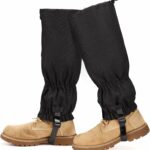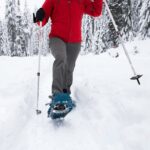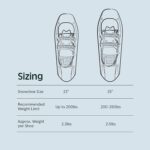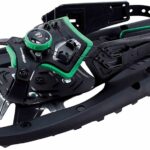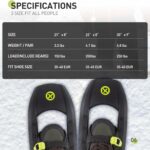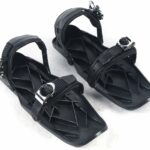Choosing the right size for your snowshoes can feel like a confusing task, but it’s essential to ensuring a safe and enjoyable winter adventure. The article “How Big Should My Snowshoes Be?” is here to clear up any of your doubts and guide you through the factors to consider whilst making this decision, such as your weight, the snow conditions, and the type of hiking you’ll be doing.
Understanding Snowshoes
Snowshoes have been a crucial tool for human survival in snowy environments for centuries. Let’s take a journey together through their history and understand their usefulness and appeal.
History of Snowshoes
Snowshoes can trace their origins back to Central Asia, where our ancestors used these ingenious tools to overcome the challenges of thick snow while hunting. The design has seen many transformations over time, making snowshoes more versatile and efficient.
Purpose and benefits of snowshoes
Snowshoes are more than just a tool – they are a passport that allows you to travel safely and effectively in regions blanketed with snow. They aid in weight distribution, provide stability, and minimize energy expenditure. This equipment allows you to hike, traverse, and even jog in snowy terrains unimpeded.
Different types of Snowshoes
There are different types of snowshoes for various snow conditions and activities. These may vary in terms of sizes, designs, materials, and traction capabilities. The right pair for you depends heavily on your specific needs, weight, and the terrain you anticipate trekking.
The Importance of Snowshoe Size
Size matters greatly when it comes to snowshoes. The perfect size can significantly influence your ease of mobility, safety, stability, and grip on the snow.
Role in mobility and safety
The right-sized snowshoes enable you to glide over the snow, reducing the amount of energy you need to move. A mismatch in size could hinder your mobility and may even put you at risk in tricky snow conditions.
Relationship between shoe size and weight distribution
The size of the snowshoe is directly related to the weight it can bear. A larger snowshoe can distribute weight over a larger area, preventing you from sinking deep into the snow.
How shoe size affects stability and grip
A shoe too small for your weight will likely lack the level of stability and grip needed to maintain balance, especially on challenging terrains. On the contrary, an oversized shoe could make walking cumbersome and tiring.
Factors Influencing Snowshoe Size
A variety of factors determine the perfect snowshoe size for an individual. It is not a one-size-fits-all scenario – the size you choose should be a carefully evaluated decision.
Your body weight
Your body weight is a primary determinant of the snowshoe size you require. The heavier you are, the more snow surface area you need to support your weight.
Your boot size
The size of your boots also plays a role. Even though snowshoes are designed to be adjustable and can accommodate a range of boot sizes, it’s essential to ensure your boots fit comfortably to avoid any issues while hiking.
Type of terrain
Different terrains demand different snowshoe sizes. For instance, open, flat terrains might require larger snowshoes compared to narrow, wooded trails.
Packed or loose snow conditions
Snow conditions significantly influence the size of your snowshoes. Powdery, loose snow may demand a larger snowshoe, while packed snow can be navigated with a smaller one.
Snowshoes for Different Activities
Just as there are different shoes for different sports, there are different snowshoes for various snow activities.
Snowshoes for hiking and backpacking
Hiking and backpacking snowshoes are sturdy, accommodating added weight and challenging terrains. They typically provide excellent traction and have adjustable bindings.
Snowshoes for running
Running snowshoes are lightweight and designed for maximum endurance. They are usually smaller and narrower, allowing for enhanced speed and agility.
Snowshoes for mountaineering
Mountaineering snowshoes are crafted to handle steep, icy terrains. They often feature advanced binding systems and aggressive crampon designs for excellent traction and stability.
Understanding Snowshoe Components
Snowshoes are comprised of several components, each playing a crucial role in their performance.
Decking material and size
The decking material affects the shoe’s durability and weight. Modern snowshoes often use synthetic materials, which are lightweight, durable, and provide good flotation. The size of the decking contributes to the overall size of the shoe and its weight-bearing capacity.
Binding system
The binding system secures your boots to the snowshoes. There’s a variety of binding types available, each having a different level of adjustability and comfort.
Crampons and traction systems
Crampons give you grip on the snow. They are strategically placed on the snowshoe to provide stability and control in different snow conditions.
How to Measure Your Snowshoes
Measuring your snowshoes correctly is essential for ensuring a comfortable and safe experience.
Measuring the length
The length of a snowshoe is measured from the tip to the tail. The correct length depends on several factors including your weight, the type of snow, and the activity you intend to perform.
Measuring the width
Snowshoe width can affect your gait and the ease with which you navigate through narrow trails. As such, it is important to find a balance between flotation and maneuverability.
Considering the footprint
Beyond physical measurements, considering the snowshoe’s footprint – how it displaces your weight over the snow surface – is equally important. This calculation takes into consideration your overall weight, including your gear and backpack.
How to Properly Fit Snowshoes
Properly fitting your snowshoes can enhance your comfort, stability, and safety while snowshoeing.
Aligning with your boots
The snowshoe bindings should align with the size of your boots, ensuring that your foot is securely in place.
Adjusting the binding straps
The binding straps should be comfortably tightened, ensuring firmness without compromising comfort.
Testing for comfort and mobility
Before you hit the snow, test your snowshoes at home. Make sure you feel comfortable walking around and can easily lift each foot.
Common Mistakes in Choosing Snowshoe Size
There are several pitfalls to avoid when choosing the size of your snowshoes.
Choosing solely based on your shoe size
While your boot size can influence the bindings of your snowshoes, it doesn’t determine the size of your snowshoes. Your body weight and the nature of the terrain play much larger roles in this decision.
Ignoring weight capacity
Ignoring the weight capacity of snowshoes can lead to sinking in the snow or breaking the shoe. Always factor in your total weight, including your gear and any extra load you may carry.
Overlooking the type of terrain and snow conditions
The size and design of the snowshoes you need can dramatically differ with the terrain and snow conditions. Be sure to consider the specifics of where and when you’ll be using your snowshoes.
Snowshoe Sizing Chart
A sizing chart can give you a starting point when deciding on the size of your snowshoes.
Understanding the sizing information
The chart contains suggested snowshoe sizes based on weight categories and sometimes additional factors. Keep in mind that these are general guidelines and individual circumstances may require adjustments.
Interpreting weight capacity
The weight capacity of a snowshoe gives an indication of how much load the snowshoe can handle. It’s important to remember this includes not just your body weight but also any additional gear or load.
How to use the sizing chart
Using the chart, identify your total weight category, and use the suggested snowshoe size as a starting point. Then, consider other factors like the type of activity, terrain, and snow conditions to make your final decision.
Expert Tips for Choosing Snowshoes
Expert help can guide you towards the perfect snowshoe size and type.
Consulting a professional or experienced snowshoer
Experienced snowshoers or professionals in the field can offer personal insights and advice on choosing the right snowshoes.
Trying on different sizes and brands
Like regular shoes, snowshoes feel different across different brands and sizes. Try a few on before making a decision to ensure you find the perfect pair.
Considering future use and potential growth
If you intend to use your snowshoes for several years or are buying for a growing child, it’s essential to consider future growth and potential changes in use.
All in all, finding the right snowshoe size involves a combination of several factors, not just your shoe size. By understanding these factors and avoiding common pitfalls, you can find the perfect snowshoes for your winter adventures.
- What Snowboard Bindings Should I Get? - January 23, 2024
- What Size Screws For Snowboard Bindings? - January 23, 2024
- How To Snowmobile On Water? - January 23, 2024

